
AC Cars: The Early Years
It all started back in 1901 when John Weller set up a small workshop in London to support his passion of building cars. Weller’s funding for the endeavor came from a wealthy businessman named John Portwine and by 1903, the first cars went from concept to reality. Back in those days, there were only two engine options for Weller’s unique car: a twin-cylinder 10 horsepower and a four-cylinder 20 horsepower configuration. They were first unveiled at the 1903 British Motor Show, where the most notable comment was “We foresee a brilliant future for the Weller ‘Autocar’ and it’s talented designer.”
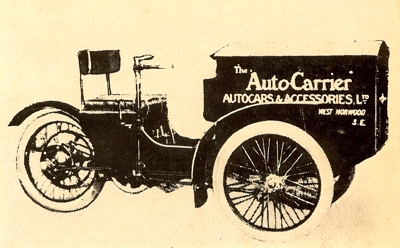
Autocar Becomes Autocarrier
In 1904, Weller’s business became Autocar & Accessories Limited, and began to produce of a small delivery vehicle called the Autocarrier. It had a 5.6hp air-cooled single-cylinder engine and was actually a tricycle by its design. The Autocarrier was a tremendous success and quickly found prominence in two London stores: Maple & Co. and Dickens & Jones. Goodyear Tires also had one for delivering new wheels and tires to wealthy car owners. Within a year, the Autocarrier was familiar on the streets of London and was considered a “must have” by any company that wanted to be portrayed as fashionable or cutting edge. In fact, one company had a fleet of more than 70 Autocarriers.
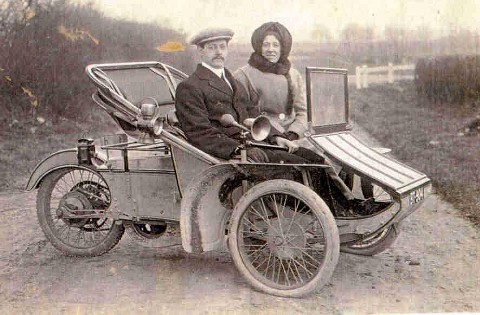
In 1907, a passenger version of the Autocarrier was introduced named the Sociable. The August 1910’s edition of “Motor Cycling” also featured an Autocarrier that was adapted for military purposes and soon after the 25th London Cyclist Regiment was issued a fleet of Autocarriers with Maxim guns mounted on special bodywork and some were outfitted as ammunition transporters.
The British Army chose the Autocarrier because of its reliability, performance, and maneuverability. Due to the increase of orders, Autocar & Accessories Limited moved to a larger shop in Thames Ditton during 1911, which was just outside of London. The Autocarrier’s simple, sturdy, and practical design supported production until 1915 and stayed in Thames Ditton where Weller designed the first production four-wheel car. By the start of the First World War, Autocarrier’s efforts were concentrated on the manufacturer of shells and fuses alongside the popular Autocarrier.
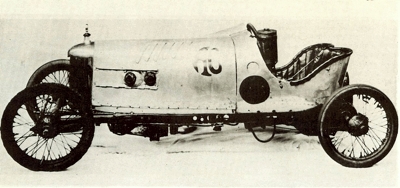
Autocarrier becomes AC: A legend is born
For the first time in 1915, the abbreviation AC was used, and in November of that year a new company was formed called Autocarriers Limited. The new company also acquired Autocar & Accessories keeping Weller and Portwine as directors. In 1918, full production of a two-seater, four cylinder AC car began and was sold for $1,020. These new ACs were immediately successful in competition, particularly in hill climbs and trials.
1921 saw the opening of new showrooms and offices on London’s Regent Street and the AC board of directors was joined by the famous English racing driver of the era, Selwyn Francis Edge, who was named Chairman of the newly named company, AC Cars Limited after Weller and Portwine resigned for irreconcilable differences. The new ACs proved to be very sporty and boasted amazing performance, stylish bodies, and several colors. The engine was a straight-six configuration utilizing aluminum pistons, aluminum cylinder block and sump with a chain driven overhead camshaft, four valves per cylinder and twin spark plugs per cylinder. Initially the engine’s capacity was 1477 cubic centimeters and produced 40hp. This was the start of a very successful time for AC from a sales and marketing standpoint. Soon the company had a new slogan: “The First Light Six – and still the best.”
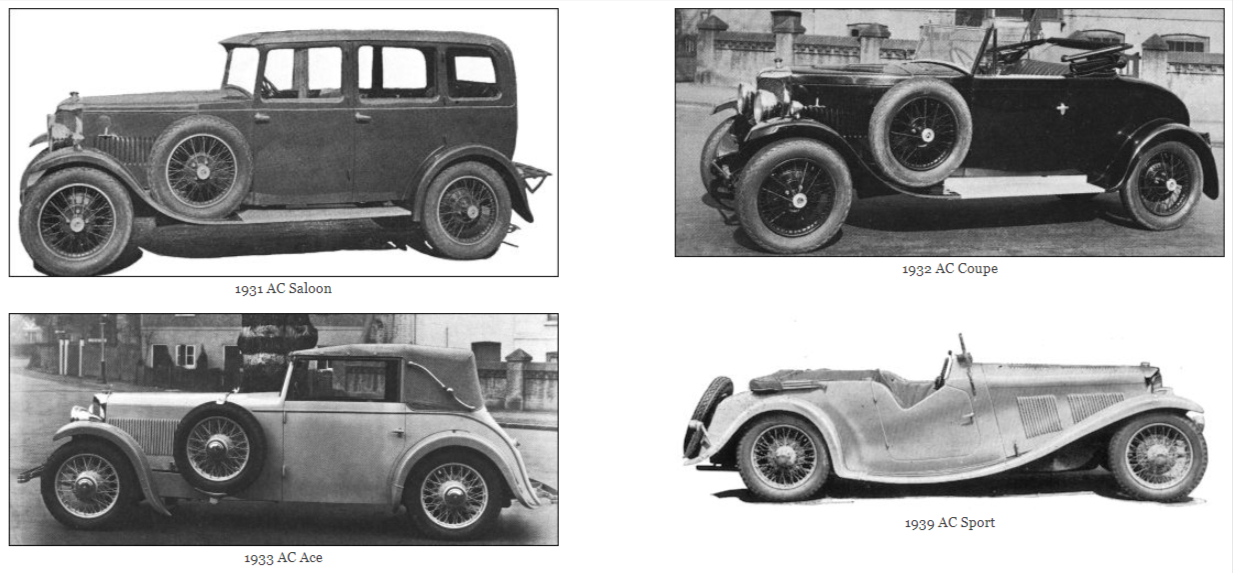
AC Firsts: History Unfolds
In 1922, AC made history by becoming the first car with a 1500cc engine to cover 100 miles in one hour at the famous Brooklands raceway. J.A. Joyce, piloting a specially prepared 16 valve four-cylinder AC, posted a record distance of 104.85 miles within the hour at Brooklands, which was only a few miles from the AC factory. In 1924, Tom Gillett using AC’s predominant light-six power set a new 24-hour record at over 82mph and in 1926, Victor Bruce and William Brunell scored the first Monte Carlo Rally for a British built car. A year later Bruce and his wife Joyce, covered 1,500 miles in nine days while in France.

The Rise of the AC Ace
During the next six years, AC introduced seven new models. They ranged from the Aceca, a two-seater coupe, to a long wheelbase coach built saloon. The output of AC’s six-cylinder engine was also improved from 40 to 56hp and by 1928; the AC Car Company was one of Great Britain’s largest automobile manufacturer. However, that success was short-lived due to the stock market crash of 1929, which forced the world into economic recession and AC into voluntary liquidation.
A short time after the Depression, William and Charles Hurlock purchased the AC Car Company in 1930 and instead of building cars, they established service facilities for existing owners. Following pressure from satisfied customers, the brothers decided that there was a market for limited production, hand made cars, and that’s exactly what they did. Throughout the 1930s the AC six-cylinder engine served faithfully and performed exceptionally in the Royal Automobile Club (RAC) and Monte Carlo rallies. Almost immediately, new showrooms sprang up in Park Lane, London and the AC Car Company was again stable and prosperous. Even the name Ace was first used in 1931. Two years later, four new cars participated to the RAC rally and each earned an unquestionable recognition. A four-seater sports version driven by Miss Kitty Brunel took the overall win and the Hurlock brothers finished fourth and sixth respectably. Mrs. G. Daniel finished seventh and even took first prize in the Concours d’Elegance.
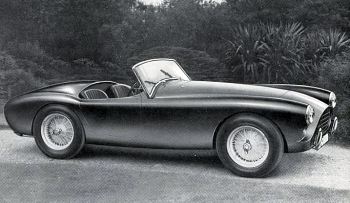
AC Bristol
From 1956, there was the option of Bristol Cars’ two-litre 120 bhp (89 kW) straight-six with 3 downdraught carburettors and slick four-speed gearbox. Top speed leapt to 116 mph (187 km/h) with 0–60 mph (0–100 km/h) in the nine second bracket. Overdrive was available from 1956 and front disc brakes were an option from 1957, although they were later standardised.
The car raced at Le Mans in 1957 and 1958. In 1959 at Le Mans, Ted Whiteaway and John Turner drove their AC-Bristol, registration 650BPK, to the finish, claiming top honours for the 2,000cc class and seventh overall behind six 3 litre cars. Few cars with this provenance have survived and are extremely valuable. They can range from $100,000 or more for an unrestored car, even one in pieces, to in excess of $400,000 for a restored AC Ace.
When Bristol ceased building their 6-cylinder engine in 1961, AC was approached by Carroll Shelby to use a Ford V8 in the Ace chassis, producing the AC Cobra in 1962. Production of the Ace ended the same year.
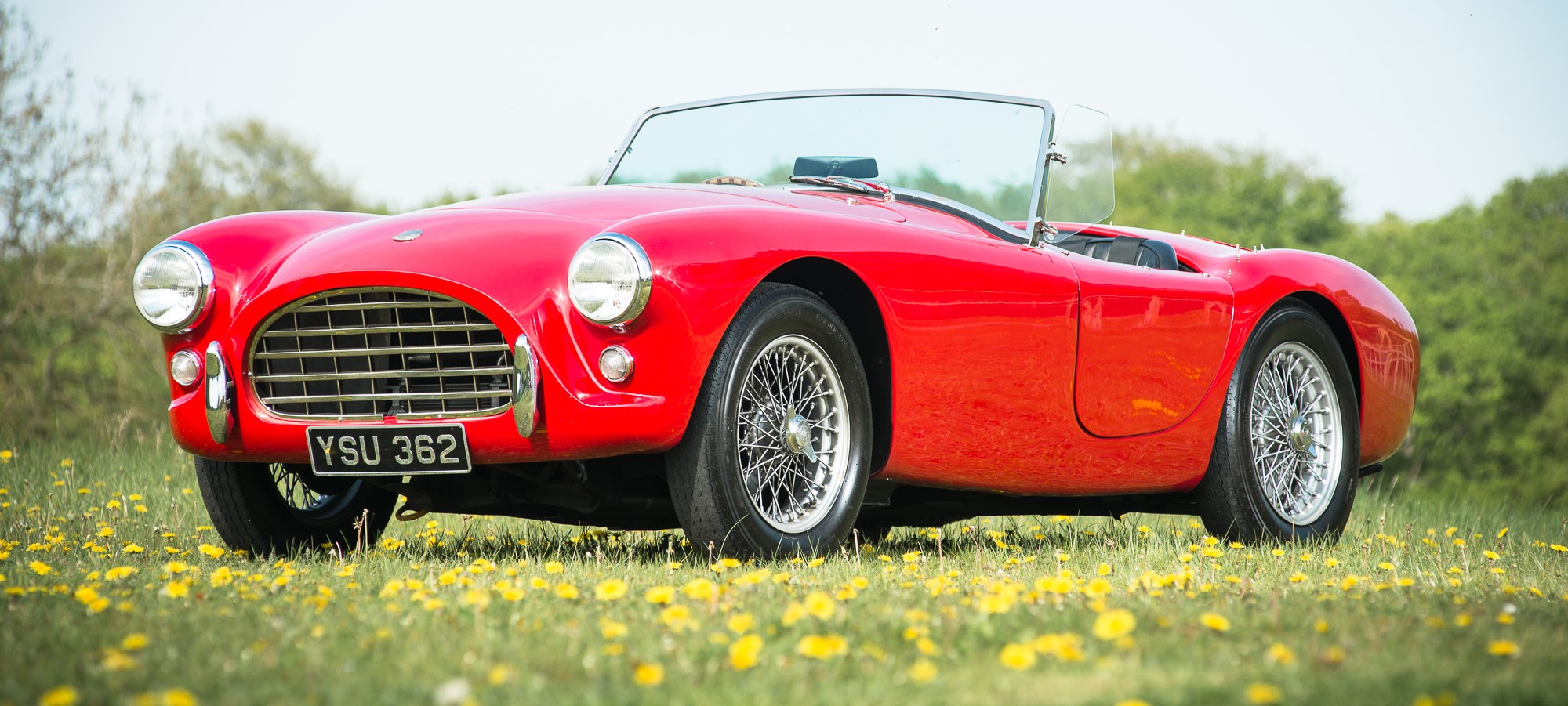
AC Comes to the USA
By 1937, AC cars were being exported to North America for the first time, however this ceased shortly with the inception of World War II and production was quickly geared towards the manufacture of firefighting equipment, aircraft parts, radar vans, flame throwers, guns and sights.
When the war ended in 1945, AC came back to building cars and its production grew steadily over the next five years. By 1950, AC Cars was rolling out five of its two-liter models a week in several body styles and in 1953, the AC Ace was introduced, which proved to be a landmark achievement for the manufacturer. The Ace was an open two-seater sports car, which quickly gained a big following amongst sporting motorists and made its mark primarily in British club competition by being the type of car that the enthusiasts could race or rally on the weekends and still use for every day motoring. In 1954, the Aceca Coupe was debuted at the London Motor show and production began the following year. 1957 also proved to be a promising year for AC Cars as the AC Bristol was introduced and finished tenth overall at the legendary 24 hours of Le Mans. 1958 was even better as the race designed AC Bristol finished Le Mans in eighth with a spec car ninth. In 1959, an AC Ace finished seventh overall and first in the GT2.0-liter class.

AC Cobra: The Shelby Years
Over the next year, AC Cars pressed on with its usual production schedule until a historic moment happened in 1961 when Carroll Shelby entered into negotiations with AC Cars. Backed by Ford, Shelby proposed the installation of a large 4.2-liter V8 in the current lightweight AC Ace. Built by AC Cars, the fusion of brute American horsepower and British aesthetics resulted in the AC Cobra, one of the fastest and most brutal sports car of all times.
By 1963, production of the hand built aluminum-bodied car had reached 15 per week. The AC Cobra also earned a seventh overall finish at Le Mans with a team managed by Sterling Moss. As the months rolled on, AC began gaining momentum due to American innovation and moved beyond the MK1 260 cubic inch 4.2-liter engine, through the 289 4.6-liter American V8, to the immense and legendary 427 S/C (Street Competition) 7.0-liter V8. The jump in horsepower forced AC to develop larger 4″ diameter chassis tubes to handle the incredible torque of the monstrous 500hp V8. At the time, the Guinness Book of Records listed the 427 AC Cobra as the fastest production car in the world, a distinction it held for many years.
AC Setting World Records
In 1964, the AC Cobra caused a huge uproar that would prove to be a benchmark for AC Cars and the AC trademark in general. In late ‘64, during a test session prior to Le Mans on the unrestricted M1 motorway, an AC Cobra reached speeds of nearly 183 mph stunning onlookers and engineers. The achievement was noted by the British House of Commons and proved so complex that British Parliament would eventually impose a 70 mph speed limit on British motorways and two lane highways. The testing achievement saw one of the two AC Cobras entered at Le Mans become the first British entry to finish. In 1965, the AC Cobra won the World Sports Car Championship and was on its way to become the most notable supercar of its era.
Between 1967 and 1973, the AC 428 was introduced and manufactured with a new steel body designed by Frua of Turin. With bodies imported from Italy, AC built 29 convertibles and 51 fastbacks before production ceased in 1973. During the 70’s and early 80’s AC developed the ME3000, a two-seater mid-engine sports car using a Ford 3.0-liter V6 engine under a composite body mounted on a steel chassis.
AC Ace Becomes the AC Mk IV
1985 proved to be another landmark year with the re-introduction into North America of the AC MkIV. This AC had a 305 V8 engine that met 50 State EPA and DOT Federal Regulations and was based on the original Cobra tooling. By 1986, most of the major automotive manufacturers were buying up niche sports car companies and Ford followed suit by entering into a joint venture with Autokraft to obtain controlling interest of AC Cars from the Hurlock family. Two years later in 1988, production was moved to a new purpose built factory sited within the old historic Brooklands racetrack complex, the scene of so many achievements by AC competition cars more than 60 years earlier.
AC During the 90’s
1990 saw the production of the lightweight version AC MkIV and the following year a new pre-production AC Ace was constructed by Autokraft with body design by International Automotive Design. The new AC Ace featured current specs completed with an electric hood, air conditioning, electric windows, aluminum body and a stainless steel chassis.
In 1992, Brian Angliss personally acquired Ford’s interest in AC Cars Limited and the lightweight AC MkIV was re-engineered to meet 1993 European Economic Community (EEC) Type Approval and North American Certification Standards. Following Approval by the EEC, the AC Ace was unveiled at the London Motor Show. Production commenced the following year and in 1995, the AC Ace was unveiled to America at the Detroit Motor Show. 1996 saw the acquisition of AC Cars by AC Car Group and Alan Lubinsky pledged to build MkIV sales and complete the development of the AC Ace. The transition allowed the AC Car Group to optimize the production process, which enabled a handcrafted finished car to be produced at a reduced price.
In 1997, the new AC Ace was introduced alongside the Superblower, which came complete with a 305 V8 producing 320hp. The following year saw the launch of the new AC Aceca, which was shown alongside the AC MkII 289 FIA Roadster, the AC Ace, and the AC Superblower.
1999 paved the way for the launch of the new AC Cobra MkIV Carbon Road Series (CRS), which was produced with a carbon fiber body instead of the traditional handmade aluminum body. In 2000, the AC 212 S/C powered by a 213 cubic inch Lotus V8 twin turbo was unveiled at the Birmingham International Motor Show.
AC Turns 100 Years Old
In 2001, AC Cars turned 100 and relocated to Albany Park, Frimley, Surrey. Shortly after, a new model was developed aptly named the AC MKV. It featured a carbon fiber body mounted on the original design steel ladder chassis and was equipped with a Ford 340hp fuel injected V8 paired to a five-speed manual transmission. The AC MKV was produced in Malta until 2007.
From 2001 on, AC Cars sought out a partner whose uncompromising commitment to quality and innovation would be worthy of the AC brand and its heritage to continue its tradition. AC’s search concluded with AC Automotive GmbH, Germany, which was chosen to help re-launch the AC brand in Europe.
Their new partnership with AC Automotive GmbH is charting a new path that will exemplify the rich heritage of the original AC Cobra. Despite AC’s unique history over the past 40 years, the brand is stronger than ever and making its return with the AC Mk VI. Not only is this vehicle a true work of art, but most importantly, each AC Mk VI and its owner’s name, is permanently entered into the official AC Cars Registry (AC Bible), which is a living record of every AC car ever made since 1901.

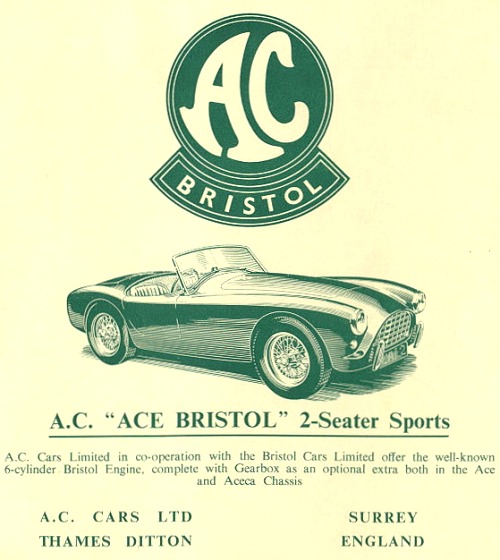
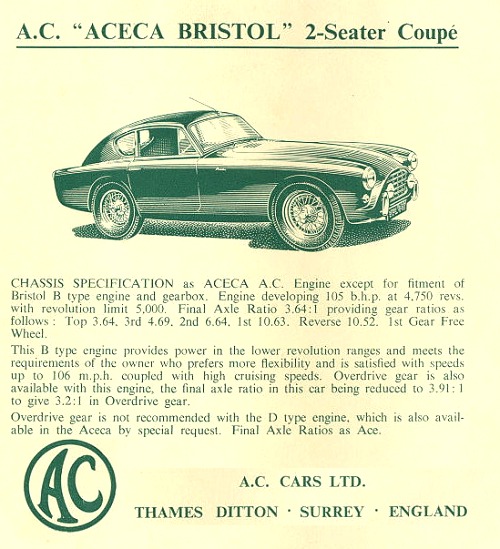
You must be logged in to post a comment.